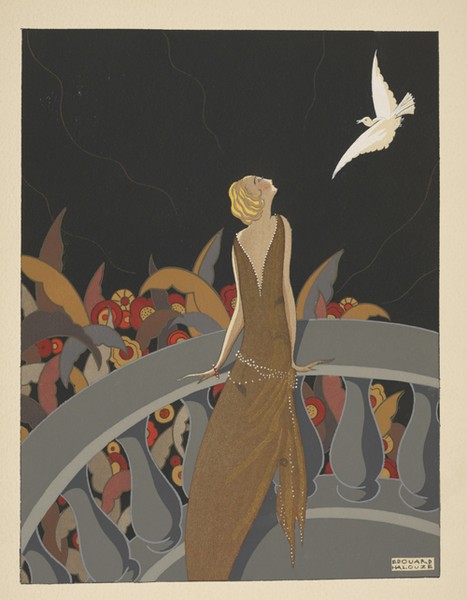You might have noticed, as I have, a proliferation of articles about “bicycle style†in recent months. Mayor Bloomberg has invested money in designating bike paths and adding bike racks to make New York friendlier to the traffic easing, eco-friendly transportation. Fashion has responded and, being the fashion culturalist I am, I’ve been slowly making links and connections to the history of bike fashions — and sportswear fashion in general — in an attempt to gain greater insight into this resurgence in popularity. Let’s start with the advent of bicycle culture and dress, shall we?
The first bicycles were manufactured in America in 1878. Strolling down boulevards was already a favorite pastime of the leisure class, but this wheeled invention fast became a popular sport. Men had little difficulty straddling these “velocipeds†in their trousers, but the heavy, voluminous, dragging skirts of the time — not to mention the upper-body immobility imposed by structured corsets which inhibited both bending at the waist and breathing — made it nearly impossible for women to participate in the exciting activity. Fashion aside, bicycling was initially deemed dangerous for women, who were not encouraged to exert themselves physically nor to assert their independence (i.e. stray too far from the domestic homefront literally or figuratively).

Bloomer costume, 1851. The bloomer costume consisted of lose harem-like pants that were collected at the ankles, worn under a skirt in the typical style of day, save its length which was roughly 6†shorter than the acceptable hemline.
Invented in the 1850s, the bloomer costume provided an obvious source of activewear for women by covering their legs while allowing them the freedom of a bifurcated garment. However it had only ever been adopted by fringe Victorian dress reformers who were ridiculed by the press as radical feminists with silly, indecent (still!) sartorial selections, and it never achieved widespread acceptance in this form. Somehow by the mid 1890s the social stigma of women on bicycles had all but vanished and as a result, “bicycle costumes†were actually lauded as preserving modesty while preserving health. These outfits bore suspicious (and unacknowledged) resemblance to the disparaged bloomer costume by alleviating some of the major fashion impediments with narrower skirts and fewer under-layers. Here is a description of an acceptable female riding outfit from 1895:
“A combination garment was worn next [to] the skin – all wool in cold weather and cotton in warm. Over this she wore no corset, but a patent waist without bones, to which were buttoned the circular bands of drawers and petticoats. It will be seen that the waist escaped much of the pressure and dragging incident to the old style of dressing, as the only bands were of the least trying shape. Her dress skirts and waists were hooked to each other all around, thus insuring their staying together, while they were loose enough for comfort.â€
Above is a pattern for a bicycling costume, sold in that same 1894 magazine. This pattern is for an adaptable costume, allowing the wearer to buckle the skirt around her legs for complete coverage of those scandalous ankles. Then she could unbuckle the skirt for a more lady-like traditional look when not on the bicycle.
I was interested to note that even in 1895, the perceived sexual transgressions of the bicycle ensemble remained an issue. One author pointedly, if humorously, wrote “The great ladies of the land will unblushingly don man’s dress, or something alarmingly like it, and jump astride their apparatus.â€
![woman-on-bicycle-1922 Woman on bicycle, 1922. Original caption: "No more messenger boys for the National Woman's Party--from president to messenger all the members of the staff are feminine. This is in accordance with the stipulation of Mrs. Belmont when she donated the National Women's [i.e., Woman's] Party headquarters. Photo of Julia Obear, messenger."](http://www.wornthrough.com/blog/wp-content/uploads/2009/06/woman-on-bicycle-1922-271x300.jpg)
Woman on bicycle, 1922. Original caption: “No more messenger boys for the National Woman’s Party–from president to messenger all the members of the staff are feminine. This is in accordance with the stipulation of Mrs. Belmont when she donated the National Women’s Party Headquarters.”

“For the well dressed man : comfort is the keynote of the modern man’s wardrobe.” Note the boxy but narrow silhouette with creeping hemlines. Note the boxy but narrow silhouette with creeping hemlines. 1922
Wars always impact fashion and WWII certainly had a tremendous impact on the styles of the 1940s. Material and dye shortages in America necessitated civilian fabric rationing and even a limited palette of allowed colors. Elegant 1930s hemlines rose to mid-calf, the bias-cut draping (a favorite 1930s innovative method of using material cut at a 45 degree angle) was too wasteful to be employed anymore, and puffy sleeves and ruffles popular in the preceding decade were all but eliminated from popular fashion out of patriotic necessity. The silhouette contracted and became boxier, more militaristic and uniform-like. For the first time, women were encouraged to join the work force to replace their boys overseas, and their work in factories further necessitated clothes cut close to the body to avoid being caught in plant machinery. (This style was gleefully abandoned with Dior’s “New Look†of 1947, which had yards of non-utilitarian skirt fabric and which embraced a curvier, feminine form once again.)
Jump ahead another few decades: though not what the era is most remembered for, track suits were introduced in the 1960s. At this time it was worn for specific physical activities like jogging and not as daily dress, but Americans worked physical fitness into their routines more and more. The 1980s saw a resurgence in obsession with athleticism, as Olivia Newton-John’s humorously dated song “Physical” (1981) attests:
Though the video is undeniably silly, the song “Physical” brought the sexual connotations of physical activity to the foreground. With exaggerated flushed and dewy makeup complimenting her workout leotard, Newton-John’s double entendre embodied the wanton women 19th century men feared would come of skimpy (i.e. shorter) clothes.
Preoccupation with the latest workout fads manifested itself in fashion quickly. Ensembles resembling aerobic workout outfits — complete with sweat bands, legwarmers, and torn oversized sweatshirts — surfaced in popular fashion and were eagerly perpetuated by pop icons like Pat Benetar and Loverboy’s Mike Reno, and seen in movies like Flashdance (1983).
This was due — at least in part — to advancement in textile technology: the invention of new thin, lightweight, stretchy materials was well suited to sportswear. As in the 1850s when synthetic dye was invented (leading to “mauve madnessâ€!), synthetic material had the property of taking especially vivid dyes extremely well, and is evidenced by all the neon colors now associated with the ‘80s. Likewise, the tracksuit and sneakers were adopted by some early hip hop musicians (all kept in ironic pristine condition). In this raging capitalist, brand-obsessed time of Regan and Thatcher, I suspect wearing clothes previously relegated to leisure activities was a subtle statement that people who could wear athletic gear had enough off-time (and therefore money) to devote to recreational sport, and an amusing side effect was that those very clothes eventually lost their cache due to widespread adoption by the public.
Though not all specifically bicycle related, all the fashion changes I outlined speak to the larger issue of popular fashion responding to the specific physical needs (or fads) of the time: like the current explosion of people using bikes as an alternative mode of transportation and the resulting cycling projects and availability of bike lanes in urban settings. Throughout the history of the bicycle, the challenge seems to have been — and to be — assembling an outfit that accommodates the peculiarities of movement on bicycles in a practical manner, while integrating into mainstream fashion in an inconspicuous way so a cyclist may ride to a destination and enter a social or professional environment without needing to change. For this, America is looking to other countries that have been using bicycles as daily (as opposed to purely recreational) transportation for much longer, like Amsterdam, Copenhagen, and London.
The New York Times reported that “Before [the London-based company] Rapha, there were two ways to be fashionable in cycling,†said Bill Strickland, the editor at large of Bicycling magazine and until recently the author of its Style Man column. “The first was to be supertechnical, and look like a pro. The other way was to be pure vintage. Rapha created a third way, starting with a premise of ‘How would I like to look in town?’ â€
Though there are infinite paths to this end, I would imagine the one unavoidable restriction must be the amount of bulk at the crotch and ankles. They must all have relatively close-cut silhouettes with as little loose material as possible around the gears, while being flexible at the waist — exactly where the dress reformers focused in the 19th century. Adding an additional layer of influence, this description happens to coincide with the male suit of the 1960s, which is also currently experiencing a surge of popularity.
Aesthetic cultural influences are at work here, including but not limited to the popular Mad Men TV series. Set in the 1960s, this show has coincided with the resurgence of skinny jeans and slimmer, shorter trousers. This is evident even in formal wear; I spotted many a slim-fit tux at this year’s Academy Awards. Which came first: the retro look or the latest bicycle movement? Like most other fashion developments, many influences across cultural, ecological, and political spectrums have impacted the collective unconscious and manifested itself in everyday dress. Isn’t it fun to try to figure them all out?
Further reading:
- “The Bicycle and Health” The Ladies’ Standard Magazine, April 1894
- “The Wheelasa Reformer; What One Woman’s Bicycle Has Taught Her About Clothes.†NYTimes, 1895
- “Cyclistas spin into style†The Gazette, May 26, 2009
- Fitness Fashion After 1960
- Copenhagen Cycle Chic blog


































2 comments
Online MBA says:
Mar 9, 2018
This is very good content you share on this blog. it’s very informative and provide me future related information.
Online MBA
Barb Chamberlain, Bike Style Spokane says:
Oct 6, 2011
I discovered your blog while compiling links for a round-up of pieces on bike-friendly pants for women. Great reading!
You’re looking at history and meaning, not specific design details, but I can tell you that for women it’s a lot more than “not a lot of bulk at crotch and ankles”. Standard pants designs with a seam right up the middle are hostile to biking comfort; there’s a reason bike shorts have that funny smooth pad in the middle. I’ve been ranting about pants all week on my blog and giving this quite a bit of thought as I pedal to and from work.
There’s another angle on this you may get into in another post (I’ll keep looking around–great blog!), and that’s whether the current Cycle Chic movement celebrates biking by anyone, anywhere, wearing anything, or whether it’s just another constrictive fashion corset into which people (women in particular) are expected to fit. (Related post on my blog: http://bikestylespokane.com/2011/08/02/wearing-real-clothes-a-radical-political-statement/)
@BarbChamberlain
@BikeStyleSpok